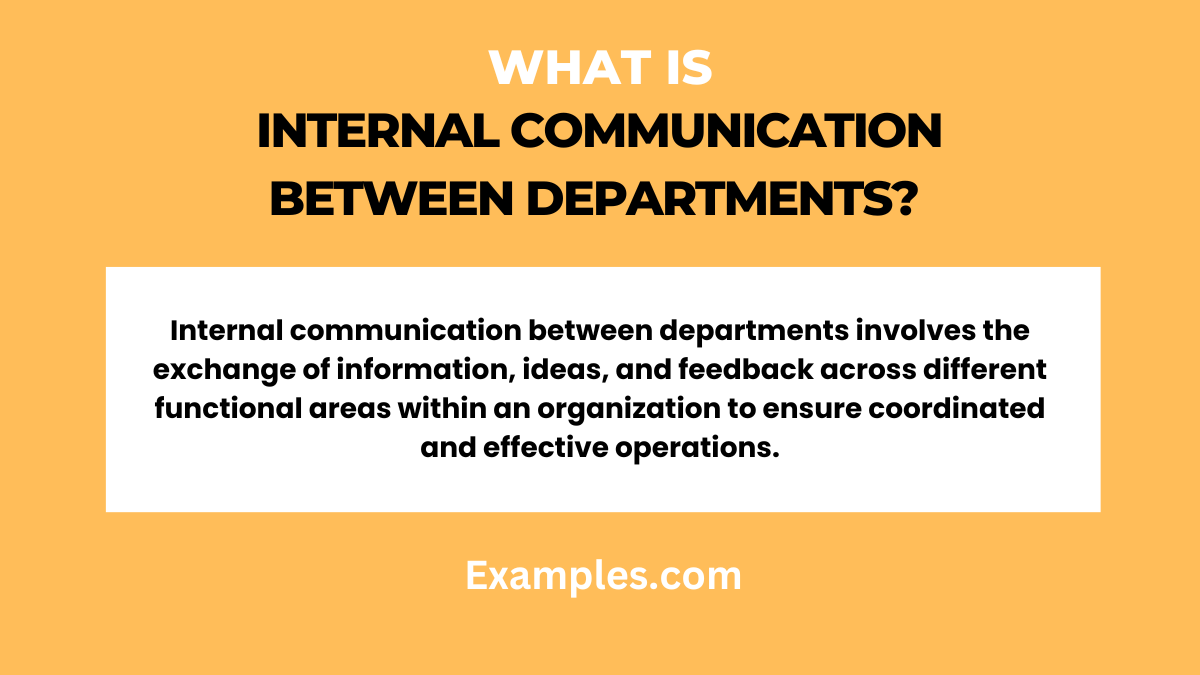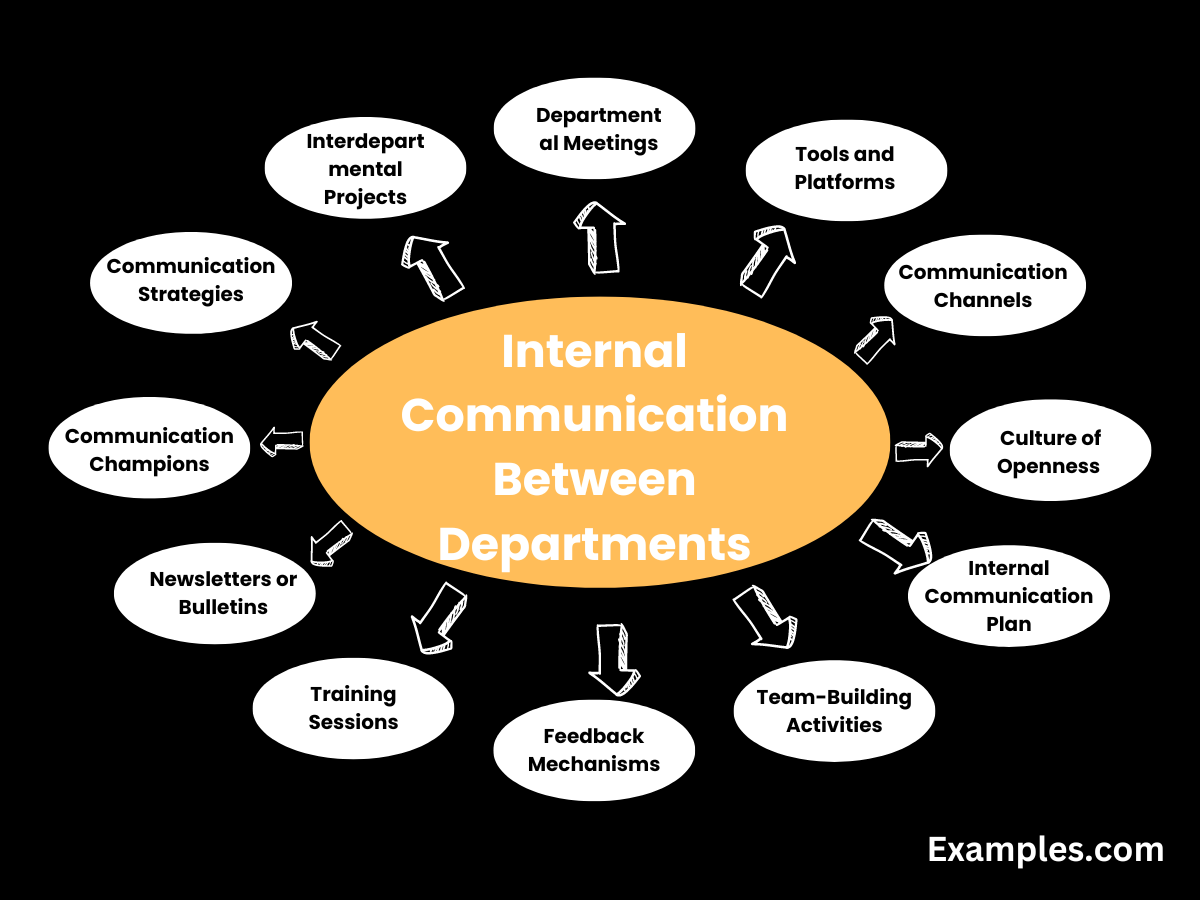12 Internal Communication Between Departments Examples
Delve into the essential guide on Internal Communication Between Departments, a key factor for organizational synergy and success. This comprehensive guide, enriched with Internal Communication Examples, explores effective strategies and practices to enhance communication across various departments. Learn how fostering clear, collaborative channels between teams can lead to improved efficiency, stronger relationships, and a more unified approach to achieving organizational goals, bridging the gap between different functional areas.
What is Internal Communication Between Departments? – Definition

Internal Communication Between Departments refers to how different departments within an organization share information, collaborate, and work together. This includes conversations, meetings, emails, and digital communications that occur between various teams, like sales, marketing, HR, and finance. Effective internal communication in this context is vital for ensuring that all parts of the organization are aligned and working towards common goals, which is essential for the smooth running and success of any business. It’s a key aspect of Internal Communication in Organizations and plays a significant role in maintaining Internal Communication Functions.
How to Improve Internal Communication Between Departments
Improving Internal Communication Between Departments is crucial for the efficiency and overall success of an organization. Here are several strategies to enhance the flow of information and collaboration across different departments:

- Implement Cross-Departmental Meetings: Regularly scheduled meetings between various departments can help in sharing updates, discussing challenges, and aligning on goals. This practice fosters mutual understanding and collaboration.
- Use Collaborative Tools and Platforms: Utilizing Internal Communication Platforms/ Tools like Slack, Microsoft Teams, or Asana can significantly improve the sharing of information and coordination of tasks between departments.
- Establish Clear Communication Channels: Define and communicate the preferred channels for different types of internal communication. Whether it’s email for formal communication or instant messaging apps for quick queries, having clear channels helps streamline the process.
- Create a Culture of Openness and Transparency: Encourage a workplace environment where employees feel comfortable sharing ideas and feedback. This openness can lead to more innovative solutions and better problem-solving across departments.
- Develop a Comprehensive Internal Communication Plan: Having a well-thought-out Internal Communication Plan can guide how information is disseminated between departments, ensuring consistency and clarity.
- Encourage Team-Building Activities: Organizing team-building activities can help break down barriers between departments and foster a sense of unity and teamwork.
- Regular Feedback Mechanisms: Implementing regular feedback channels can help in identifying issues in inter-departmental communication and addressing them promptly.
- Cross-Departmental Training Sessions: These sessions can help employees understand the roles, challenges, and goals of other departments, fostering empathy and better communication.
- Utilize Internal Newsletters or Bulletins: Regular internal newsletters or bulletins can keep all departments informed about company-wide news, successes, and updates.
- Appoint Communication Champions: Having designated individuals in each department responsible for communication can ensure that messages are relayed effectively and efficiently.
- Monitor and Review Communication Strategies: Regularly assessing the effectiveness of internal communication strategies and making necessary adjustments can lead to continuous improvement.
- Promote Interdepartmental Projects: Working on joint projects can naturally improve communication and understanding between different departments.
Improving internal communication between departments is not just about implementing new tools or processes; it’s about creating a culture where open and effective communication is valued and practiced. By adopting these strategies, organizations can enhance their Internal Communication Techniques, leading to improved collaboration, productivity, and overall organizational health.
Tips for Internal Communication Between Departments
Effective Internal Communication Between Departments is essential for the smooth operation and success of any organization. Here are some practical tips to enhance inter-departmental communication:
- Encourage Open Dialogue: Foster an environment where employees feel comfortable sharing ideas and concerns across departments. Open communication builds trust and breaks down silos.
- Set Clear Objectives: Clearly define the goals of inter-departmental communication. When everyone understands the purpose and benefits, they are more likely to engage effectively.
- Utilize Technology: Leverage Internal Communication Tools like collaboration software, which can streamline communication and project management across different departments.
- Create Interdepartmental Groups: Form groups or committees that include members from different departments to discuss specific issues or projects, enhancing mutual understanding and collaboration.
- Regular Updates: Keep departments informed about each other’s projects and progress. Regular updates can prevent misunderstandings and keep everyone on the same page.
- Recognize and Address Barriers: Identify any barriers to effective communication, such as differing departmental cultures or jargon, and work towards resolving them.
6 Ways to Improve Internal Communication Between Departments
Improving communication between departments is crucial for organizational efficiency and effectiveness. Here are six ways to enhance this crucial aspect of Internal Communication in Organizations:
- Scheduled Cross-Departmental Meetings: Regularly scheduled meetings between departments can ensure consistent communication and provide a forum for discussing joint issues and goals.
- Integrated Communication Platforms: Implement Internal Communication Platforms/Tools that allow seamless sharing of information and collaboration, such as shared digital workspaces or integrated communication systems.
- Cross-Training Programs: Implement cross-training programs where employees spend time in other departments. This exposure helps in understanding the roles and challenges of other teams, fostering empathy and better communication.
- Feedback Mechanisms: Establish formal and informal feedback channels to allow departments to express their communication needs and preferences.
- Joint Team Building Activities: Organize team-building activities that involve members from different departments to build rapport and improve informal communication.
- Clear Documentation and Processes: Ensure that all departments have access to clear, documented processes and policies. This transparency helps to reduce confusion and miscommunication.
By applying these tips and ways, an organization can significantly improve its Internal Communication Between Departments, leading to a more harmonious and productive work environment. These efforts not only aid in day-to-day operations but also contribute to the long-term success of the organization.
In conclusion, enhancing Internal Communication Between Departments is pivotal for organizational harmony and efficiency. This guide provides actionable strategies and tips to foster better inter-departmental communication. By implementing these practices, organizations can expect improved collaboration, clearer understanding across teams, and a more cohesive work environment, all contributing to the overall success and productivity of the business.



